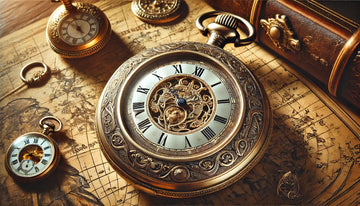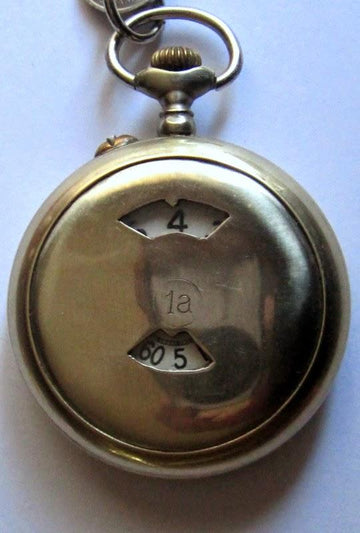
Can you imagine for a moment a pure steamer taking out his smartphone or consulting his connected watch on his wrist ⌚ to know the time? No of course not! Walking up his chain, the steamer elegantly grabs his watch from the gusset of his vest or pants, gently opens the clamshell and tells you, "I'm late, always late! "if he's the white rabbit from Alice in Wonderland or "In fifteen minutes, there's a showing of Twenty Thousand Leagues Under the Sea in Eldorado, how about that? "if it's normal.
The Pocket watch has gradually disappeared since the beginning of the 20th century in favor of the wristwatch, which was itself disappearing in favor of the cell phone.
But when it became connected, the wristwatch regained its place. It is therefore logical that the Pocket watch is making a comeback today! Do you follow me? History is an eternal restart. The story has come full circle and prestigious watchmakers have even taken over the manufacture of the Pocket watch.
Nevertheless, it remains an original product that steamers love and the Pocket watch could not but become their indispensable accessory.
But how did Pocket watch fashion born ?

Man has always been concerned with the passing of time and, as early as the 4th century BC, the Egyptians had already made the sundial. After the hydraulic and then mechanical clocks, he racked his brains to obtain the perfect mechanism that could be miniaturized to have the time everywhere and in all circumstances. He came up with the first portable watch, usually worn as a pendant, in the 16th century, and later with the Pocket watch. Gradually, the wrist watch - which was initially worn only by women - replaced the Pocket watch.
But this was without counting on the steampunk movement, which could not but resurrect this object perfectly in line with this aesthetic trend.
First of all, the Pocket watch belongs to the Victorian era, having reached its peak at the end of the 19th century, and secondly, it is infinitely classy both in its design and in the way it is worn.
Whether you choose the chain or the ribbon, there is something romantic, even poetic about the handling of the Pocket watch.
The gesture of pulling it out of your pocket is similar to the fluid movement of the magician who will make a wonderful object appear in the palm of his hand. With a flick of the wrist, you open the clamshell and take a look at its almost always Roman numerals, in its round, perfect frame, spared the unsightly lugs that hold the strap of the classic watch. There is an old-fashioned pleasure in looking at the Pocket watch that is foreign to those who turn on the screen of their cell phone.

Besides, the movement doesn't care if the Pocket watch was originally reserved for men, in its steampunk version, it is nobly worn by both steamers and steamed.
It is the final touch to complete the perfect look associated with the steampunk movement, and it doesn't matter if it is a woman's or a man's Pocket watch.
Precious object it was, precious object it remains.
Did you know that the Pocket watch of the Titanic steward, Edmund Stone, once held the record for the most expensive object saved from the sea at auction?
Its €130,000 price tag has since been beaten, but it still marks 2:16 a.m., the time when the unfortunate steward, who held all the keys to the first class, was swallowed up in the icy waters.
The story of a pocket accessory for mastering time.
Let's put ourselves in a little historical context to visualize and understand the time of people in ancient times. With the stars as reference points, which will define the seasons, we will start using the hourglass. Naturally, the sun and the candle will also be used at night. The candle which will allow during a theater for example, to define the beginning and the end of a first act. A reliable way to count the hours, although a bit constraining.

An accessory appeared in the 16th century when mechanical elements began to be refined, the Pocket watch. The gusset is this small pocket located in the interior of a jacket and which therefore allowed to store the watch. In addition to its function of measuring time, it was long considered a accessory in its own right. The most affluent people had watches that matched the clothes of the time, especially the costume, they were used to distinguish men and assess the rank of the latter in society.
This bijou was admired and in the eyes of its owner was priceless. According to traditions, a watch was among the inheritance of a man, to be passed on from generation to generation. That's why nowadays, a rare few still own an original Pocket watch.
The bracelet watch and pendant watch for men or women?

Historically men only wore pocket watches. Early wristwatches and pendant watches were reserved for women. The smaller size was nice, but the accuracy was sorely lacking, making it therefore mainly an object of fashion and refinement.
It was not until almost the First World War that we saw a radical change in this custom. Indeed, on a battlefield, to synchronize the squads and especially the first planes, soldiers began to use them for its practicality where one could monitor at a glance the time on his wrist. Having become indispensable, the wristwatch then experienced an intensive industrialization, gradually making our beautiful vintage and steampunk watches disappear (well not quite fortunately).
Quartz or mechanical, manual or automatic?

When you turn the wheel: if it turns in a vacuum it is a quartz watch. If you feel a little resistance it is a mechanical watch. The quartz watch has a battery and will last less time since it has electronic components.
There is the mechanical watch with manual winding or the automatic mechanical watch. The mechanical watch with manual winding: it is necessary to regularly wind the watch manually by turning the crown.
.The automatic mechanical watch: the watch is wound by the movements of its owner's wrist. A rotor or "masselotte" (half disk) turns on its axis with each movement and winds the timepiece. However, it is still possible to wind it manually.
Why wear a manual wound watch

Now we all have our phones or connected watches... but there's nothing like a watch with work on it in the end, which admittedly cost a little more but is a great object, sometimes a transmission of time. It's a beautiful legacy to pass down from father to son, mother to daughter.
Look at modern items as they are disposable, rarely lasting more than five years. Watches made in the rules of art, with rubies and other precious stones used, prevented the weathering and movements from stopping and breaking. The materials used were very very strong.
here you go, give yourself a pocket watch simple and pretty at first, you will learn to appreciate this outdated and precious object and will also become like us passionate about these accessories out of time that goes so well with the steampunk.




